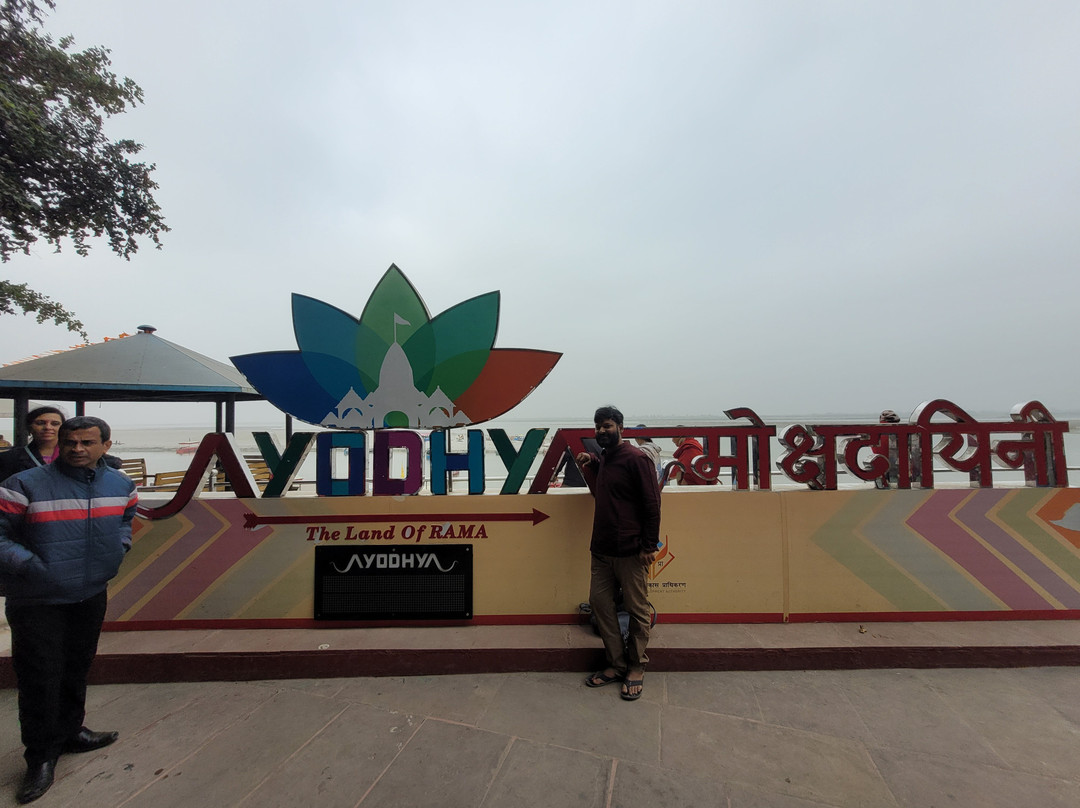的点评
Guptar Ghat is the place where Lord Rama meditated during his exile and took Jal Samadhi,
Guptar Ghat的点评
点评:Guptar Ghat is a revered site in Ayodhya, situated on the banks of river Sarayu which is located at a distance of 10 km away from Ayodhya Railway station. The Ghats in Ayodhya offer a glimpse into the rich spiritual heritage of this ancient city which is one of the Seven must visit sacred cities of India for all Hindus. Out of all Guptar Ghat is must visit place for Hindus as it has historical importance. Adjacent to Guptar Ghat lies the Company Garden known as Guptar Ghat Garden, which is must visit place for nature enthusiasts. Among the various temples situated here, the Sita Ram temple, Chakrahari Shrine and the Narsingh temple are the most popular. It is believed that taking a dip in the Sarayu river will free them of their sins and the worries of life.
History of Guptar Ghat:
The history of Guptar Ghat stretches back to the epic Ramayana. Sage Agastya in response to Sage Vasudeva's inquiry, narrates the divine play of Lord Rama's departure to Vaikunta through Guptar Ghat in the Skanda Purana. As lord Rama's mission on earth neared its end, He made the momentous decision to return to Vaikunta.
Guptar Ghat is the place where Lord Rama meditated during his exile and took Jal Samadhi, before departing for his heavenly adobe of Vaikunth.
History of Guptar Ghat:
The history of Guptar Ghat stretches back to the epic Ramayana. Sage Agastya in response to Sage Vasudeva's inquiry, narrates the divine play of Lord Rama's departure to Vaikunta through Guptar Ghat in the Skanda Purana. As lord Rama's mission on earth neared its end, He made the momentous decision to return to Vaikunta.
Guptar Ghat is the place where Lord Rama meditated during his exile and took Jal Samadhi, before departing for his heavenly adobe of Vaikunth.
翻译:古普塔尔河坛是阿逾陀备受尊崇的圣地,坐落于萨拉尤河畔,距离阿逾陀火车站10公里。阿逾陀的河坛展现了这座古城丰富的精神遗产,是所有印度教徒必游的印度七大圣城之一。古普塔尔河坛因其历史意义,是印度教徒必游之地。古普塔尔河坛毗邻古普塔尔河坛,是自然爱好者的必游之地。在众多寺庙中,西塔·罗摩神庙、查克拉哈里神庙和纳辛格神庙最为著名。人们相信,在萨拉尤河中沐浴可以洗清罪孽,摆脱生活中的烦恼。
古普塔尔河坛的历史:
古普塔尔河坛的历史可以追溯到史诗《罗摩衍那》。圣贤阿伽斯提亚在回应圣贤瓦苏戴瓦的询问时,讲述了罗摩神经由古普塔尔河坛前往外琨塔的神圣故事,这在《韦陀往世书》中已有记载。当罗摩神在人间的使命即将结束时,他做出了返回外琨塔的重大决定。
古普塔尔河坛是罗摩神在流放期间冥想和进入水三摩地(Jal Samadhi)的地方,之后他启程前往他的天堂外琨塔。
古普塔尔河坛的历史:
古普塔尔河坛的历史可以追溯到史诗《罗摩衍那》。圣贤阿伽斯提亚在回应圣贤瓦苏戴瓦的询问时,讲述了罗摩神经由古普塔尔河坛前往外琨塔的神圣故事,这在《韦陀往世书》中已有记载。当罗摩神在人间的使命即将结束时,他做出了返回外琨塔的重大决定。
古普塔尔河坛是罗摩神在流放期间冥想和进入水三摩地(Jal Samadhi)的地方,之后他启程前往他的天堂外琨塔。


此点评仅代表旅行者个人的主观意见,并不代表TripAdvisor以及其合作方的意见。
关于我们
|
新闻动态
|
商务合作
|
会员中心
|
业主中心
|
业主通
|
常见问题
|
意见反馈
|
联系我们
|
营业执照
© 2025 Tripadvisor 版权所有。
使用条款 |隐私政策 |网站工作原理
部分照片由 VFM Leonardo 提供。
* Tripadvisor不是旅行社,也不是旅游预订服务代理商。我们提供免费、客观、公正的旅游资讯服务。 (显示更多)
TripAdvisor LLC 既不是预订代理商,也不是旅游运营商,不会向网站用户收取任何服务费。 按照规定,在 Tripadvisor 发布机票价格、游览和旅行套餐的合作伙伴(航空公司、旅行提供商及预订代理商),其标价须包含所有费用和附加费用。 例如, 机场出入境税费、消费税与其他服务费、手续费、杂费及附加费用。 当您向我们的某个合作伙伴进行预订时,请务必查阅他们的网站以了解当地行政部门要求的所有适用费用的具体情况。 除非另有说明,机票价格通常指的是一个人的价格(以人民币计)。
为方便起见,TripAdvisor LLC 根据从我们的预订合作伙伴获取的空房率计算每个酒店的均价。 对于游览和景点来说,所显示价格通常是每位成人的最低可用价格。 对于列出的任何旅行套餐或优惠,TripAdvisor LLC 无法保证任何特定的费率或价格。 此外,酒店均价每晚会更新,并以您的首选币种表示(使用现行汇率)。 由于这些已换算的价格是预估价格,因此,有关具体金额和币种请与预订网站进行核实。
此外,TripAdvisor LLC 无法保证我们网站上宣传的价格随时有效。 标价可能需要预订一定天数才能生效,或有不可用日期、使用条件或限制。
TripAdvisor公司对外部网站的内容一概不负责。优惠价格中不含税和其他费用。
ICP证:沪B2-20200433
沪ICP备20013175号
 沪公网安备31010502005427号
沪公网安备31010502005427号鹰程信息技术(上海)有限公司
货币/国家及地区
¥CNY
中国

